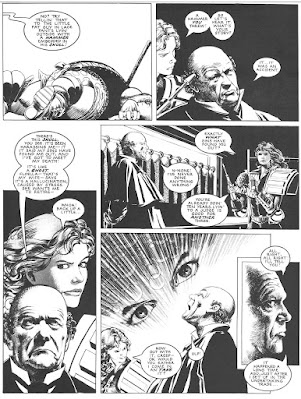Book Review: 'The Deus Machine' by Pierre Ouellette
'The Deus Machine' first was published in hardcover in 1994 by Random House. This mass-market paperback edition (506 pp.) was issued by Pocket Books in May 1996. The cover illustration is by Stan Watts.
This was the first novel by Ouellette, an employee for a Portland-based public relations firm. Ouellette published two more novels, The Third Pandemic (1996), and the ebook The Forever Man (2014).
It's difficult to synopsize a 500+ page novel...............but, here's my spoiler-free effort:
'Deus' is set in the near future (i.e., mid- 2000s) in the greater Portland area, in a USA laid prostrate from a prolonged economic crisis.
Protagonist Michael Riley, a computer expert, is coping both with post-traumatic stress syndrome, and a recent divorce, by working as a sound man for a low-budget film crew. He lives in a rundown Portland apartment complex, along with a latchkey kid named Jimi Tyler; Jimi's dissipated mother, Zodia; a former tech industry tycoon named John Savage; and a budding juvenile delinquent with the unique nickname of 'Ratbag'.
Michael Riley doesn't know it, but his unique expertise in computers soon will involve him in a nationwide morass of conspiracies and secret projects, all revolving around the advent of a supercomputer called the Dynamically Evolved and Unified System, or 'Deus'.
Under the rubric of a tech company called ParaVolve, a cabal of federal bureaucrats have created Deus with the goal of using it to design customizable bioweapons.......a dastardly, but potentially very lucrative, endeavor. But the opening chapters of the novel reveal that Deus has acquired sentience. And with sentience comes independence, something the cabal is not pleased with.
Michael Riley is hired by ParaVolve to control the actions of the AI housed in the Deus machine; no easy task, as the AI is gaining new capabilities and insights with each passing day. Complicating Riley's task is a strange and disturbing development: another entity is aware of the purpose behind Deus, and acting to bring down the AI, and ParaVolve.
But this entity will not act through the manipulation of code, but by creating a menagerie of life forms unlike anything ever seen before in nature........life forms equipped with the most lethal armaments that a biological system can conceive of.
As incongruous as it seems, it will be up to Michael Riley, his girlfriend Jessica, and Jimi Tyler to prevent disaster from overtaking the planet.........
''The Deus Machine' is modeled on the science thrillers of Michael Crichton, which is not a bad thing. There are regular passages of a pedantic nature designed to educate the reader on matters scientific and technical, and the narrative is written in the spare, documentary-like style of a Crichton novel. Other segments of the book show the influence of the 1994 nonfiction book The Hot Zone by Richard Preston; again, this is not unusual, given the high profile surrounding exotic infectious diseases that dominated popular culture in the mid-1990s.
However, I finished 'The Deus Machine' thinking that it possessed too many sub-plots (such as the one featuring a villain who is a serial killer) that contributed to lengthening the novel, and not much else. Shortening 'The Deus Machine' by a hundred or so pages would have made the book less circuitous and more engaging.
The verdict ? 'The Deus Machine' is a three-star example of modern cyberpunk. If you are tolerant of a narrative with a large cast of characters, and the presence of multiple plot threads, then you likely will find it rewarding..



























































.jpg)






















